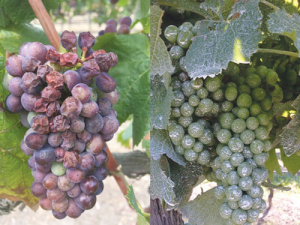How can you protect grapes from inevitable UV damage in summer?
You may think climate change is something we will face in the future, but going by last summer, it may already be here.
There has never been a season like it, Jeff Sinnott from Vinesense says of the 2018 Central Otago summer. Days of extreme heat from December through to February eventuated in the earliest harvest ever – in some places 33 days early when compared with the long-term average.
Pity the poor grapes when the vineyard is hitting temperatures into the high 30’s.
How can you protect that fruit from the inevitable sunburn that accompanies such highs?
That was the question Sinnott found himself asking, when one block was inadvertently leaf plucked in early January.
The contractors went in to trim and as they have done every year before, they also leaf plucked. Before Sinnott could call the plucking off, a certain amount of fruit had already been exposed.
“It probably cost that vineyard one tonne per hectare as far as yield depressions are concerned. The block that had not had the leaf plucking, that was fine. But any fruit that was exposed particularly to the afternoon sun just simply got fried.”
Given the average yield for Pinot Noir in Central is 6.5 tonnes per hectare, with prices being between $3500 to $4000 per tonne, it was a costly mistake.
But the high temperatures continued and Sinnott wanted a way of protecting as much of the rest of the block as he could from UV damage.
After contacting a winemaker friend in the Hunter Valley, who has had to deal with heat extremes on a regular basis, he was told to consider spraying a bentonite suspension onto the vines, to act as a UV barrier.
“It forms a film over the fruit, basically over anything it hits. It’s a brilliant material because it has a huge capacity for expansion.”
The beauty of bentonite is it is already an accepted wine additive being used as a protein stabiliser in the winery, so there are no issues surrounding spray residue.
And the best news of all, it worked. Despite continual high temperatures no more fruit was damaged by sunburn. Which means if this summer looks like being a repeat of 2018, he will be the first to provide UV protection via bentonite.
“We know the signs now and know what to expect. If things look like they are going to do the same thing, we will probably use the bentonite around Christmas time. But I can tell you this, we won’t be leaf plucking.”
It is advisable to use a product that has a rainfast sticker with it, Sinnott says, as bentonite sprayed on its own will wash off in the next rainfall.
One of the other lessons learned from the extreme heat of summer 2018, is the impact of sulphur sprays on fruit, once the heat hit.
“Even though we spray at night or in the early morning and not when it is hot, we found that some of the blocks that had recently been sprayed with elemental sulphur suffered more burn. Once the UVs became high, it made the sulphur burn worse. So if you see a spike coming, change the chemistry to a different product that is less susceptible to burn.”





